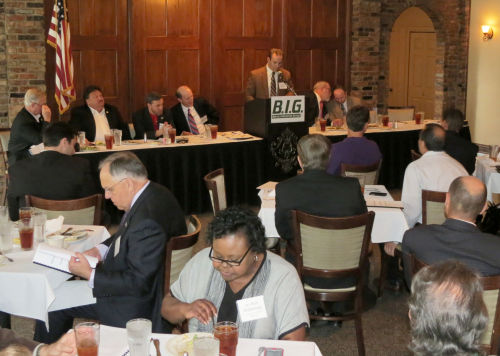
Lawmakers name priorities as session nears
February 5, 2013OUR VIEW: Big game is over, but big party rolls on
February 5, 2013One man without family, living in a car in a field, potentially suffering because he was not taking required medications, may not appear as a crisis requiring use of police resources, or a tragedy worthy of response. But two deaths – including that of a beloved police officer – can certainly be seen as such.
The looming question, advocates suggest, is not whether St. Mary authorities should have employed a crystal ball, but whether they could have attempted to intervene because of Wilbert Thibodeaux’s immediate situation. Once stabilized by medications, from what neighbors had said, Thibodeaux deteriorated in front of their eyes, potentially as a result of not continuing his medicines.
“Untreated mental illness is one of the major public health crises in America today,” said Ron Honberg of the National Alliance on Mental Illness in Alexandria, Va. “When you look at the numbers of people not being treated and yet never talked about.”
He and other advocates referenced Gov. Bobby Jindal’s refusal to expand the state’s Medicaid program under new federal rules.
“In states that expand Medicaid people with mental illness could be the number-one beneficiaries,” Honberg said. “If you have Medicaid, you have a better chance of getting treatment. Instead of political posturing what we need is sustained direction.”
In some places – Louisiana’s Calcasieu Parish is one – police agencies have employed a tried and successful program called the Crisis Intervention Team.
A Crisis Intervention Team of officers specifically trained to deal with mentally ill people can save lives by adding knowledge peculiar to situations involving them.
But the CIT approach also involves partnerships between police and the medical community.
This type of cooperation, experts say, puts protocols in place that can ease the burden on law enforcement by cutting down on the time officers spend at psychiatric emergency rooms waiting for determinations of whether people at risk should be kept for further treatment.
It is by no means a panacea. But advocates of such approaches say they can make a difference in outcomes.
As the national discussion on how to cope with people in emotional crisis grows, thanks to last year’s spate of headline-grabbing mass shootings, organizations like NAMI and the International Association of Chiefs of Police are working together on national programs that will help.
“The sad reality is that of the 18,000 law enforcement agencies in the country, over 12,000 are serving populations under 50,000, many of those smaller, rural agencies,” said IACP spokeswoman Elaine Deck. “There is not specific training at the academy level that is comprehensive on this topic.
“Often the training has been costly and out of reach for smaller police and sheriff’s departments. Now the US Bureau of Justice Assistance has provided grant dollars to support IACP and a few other law enforcement agencies like the Police Foundation, Police Executive Research Forum and Center for State Governments to study and develop policy and protocol and training that is grant-funded. Because of the variation in state and local agencies and state laws, many smaller, rural agencies have not had access to this knowledge or training.”
Some advocates for mentally ill people say that if Thibodeaux had been walking on Flat Town Road bleeding after severing an arm, police agencies would not hesitate to take the initiative in responding. Why then, they question, should a police response – even if clear questions were not asked by people calling to report Thibodeaux’s mental condition – not take the initiative to respond and check out the problem.
The official responses in the wake of the shooting clearly indicate disconnection between agencies.
As St. Mary Sheriff’s Office officials shut down any information regarding their routine policies for dealing with mentally ill people at risk, state health officials questioned about ways law enforcement can better aid the overall response had little to say.
Ken Pasternak, spokesman for the Louisiana Department of Health and Hospitals, which oversees the state’s Office of Behavioral Health, questioned why his agency was asked for comment at all.
Such responses are precisely the reason, advocates say, why dialogue between all segments of communities is required to develop programs, protocols and procedures.
“Let’s talk about the shortfall of resources in Louisiana,” said David Precise, director of NAMI’s Louisiana branch in Baton Rouge. “Quite simply, we do not have anywhere close to the appropriate budget to meet the demand of this problem. Only 17 percent of adults who have the most serious mental illness actually receive public mental health services. More than likely the shooter in (this) case is one of the 83 percent who could have been treated, but for various reasons, he was not.”
Clarification of misperceptions and myths about mental illness, Precise and other advocates say, is needed for serious discussions on meeting the challenge to take place.
“This discussion is not about blame, it is to illustrate a huge problem that we simply need to address in Louisiana,” he said. “The first part of progress would come if people were simply open to speaking about mental illness instead of inaccurately just saying that someone ‘has gone crazy.’ Mental illness is a medical condition that involves brain chemistry and circuits in your brain misfiring.”
Even where help is available, advocates maintain, actually getting someone stabilized to a point where they are not a threat can be daunting.
In Louisiana, coroners are charged with determining whether an individual can be taken against their will to a hospital absent an immediate emergency, where medical professionals can make a determination made after that.
Doing the right thing for the right reasons before a tragedy occurs – making treatment easier to receive and staying on top of the complex web of laws that govern commitment – is how advocates say society as a whole can benefit in the long run, and how lives can be saved.
The advocates walk a fine line, however. While they wish to address the problems that occur when things go wrong, they also know that fear fed by myths can have a backlash effect, and endanger members of their families or friends who suffer from illnesses.
“Only 1.0 percent of people with schizophrenia commit violent crimes, while 2.3 percent of the general population commits such crimes,” said Precise. “The general public needs to stop being afraid of mental illness and start telling our state to help these people and their families.”










